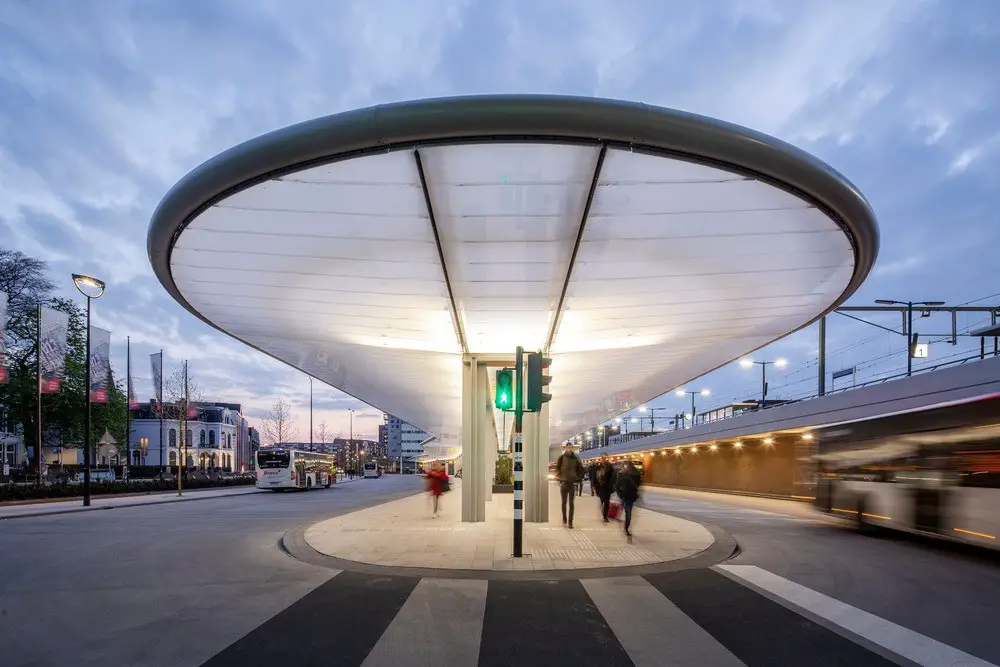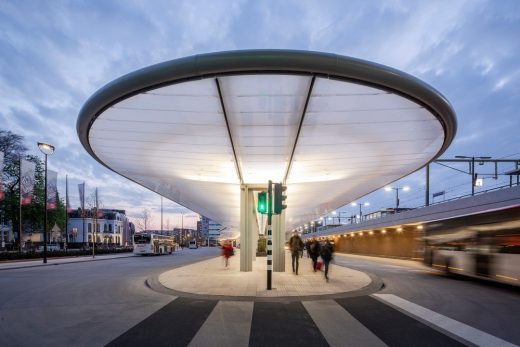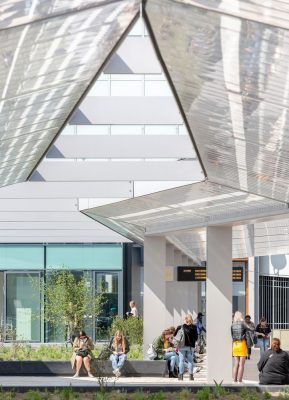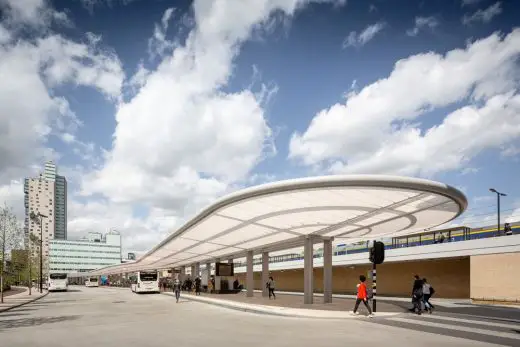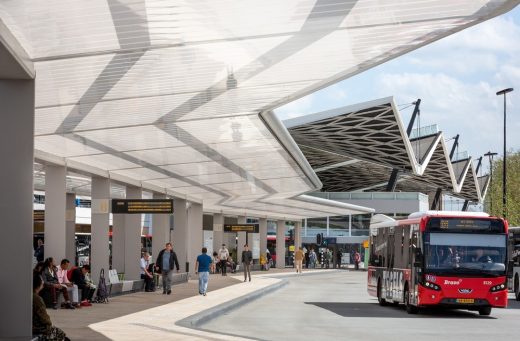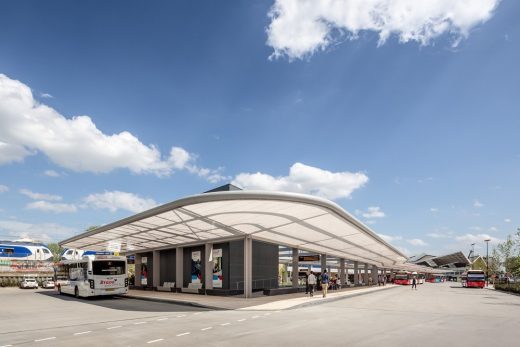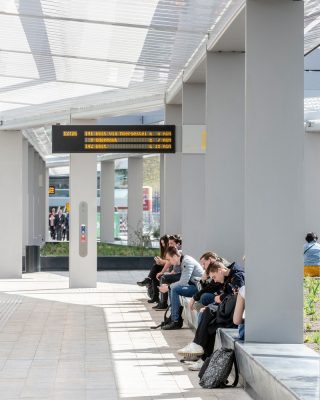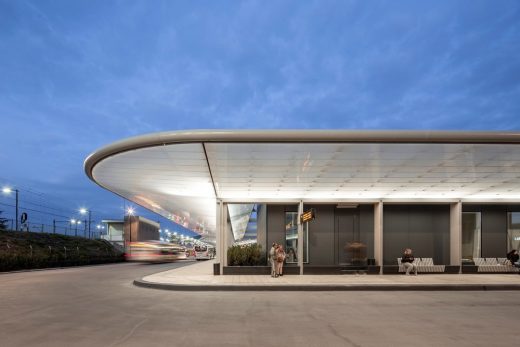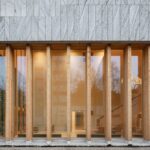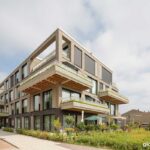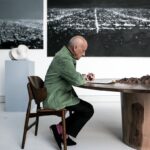Tilburg Bus Station, Netherlands Public Architecture, Dutch Sustainable Development Project Images
Tilburg Bus Station in Holland
New Sustainable Building Development in Holland design by cepezed architects, NL
1 May 2019
Architect: cepezed
Location: Tilburg, The Netherlands
Tilburg Bus Station Building
Recently, the new Tilburg Bus Station was taken into use. Just like the renovation of the train station and the new bicycle parkings in the railway zone, the bus station was designed by cepezed architects. The new public transport facility generates its own energy and its design is thoroughly integrated.
The new bus station is a part of the large-scale revitalization of the Tilburg public transport hub. It is fully tailored to the comfort of the travellers and to a clear and pleasant traffic flow. The facility is situated on the west side of the train station, roughly at the place that also occupied the former bus station, but with the location of the former Tilburion apartment block included on the far west side.
Minimalistic circuit
The basic setup consists of a series of very thin columns with an evenly minimalistic awning structure on top of them. The construction forms a triangular circuit with a length of over 160 meters and an open space in the centre. The bus positions are arranged around the outer side; six for boarding and one for deboarding.
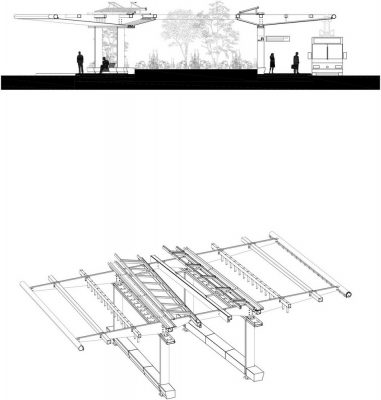
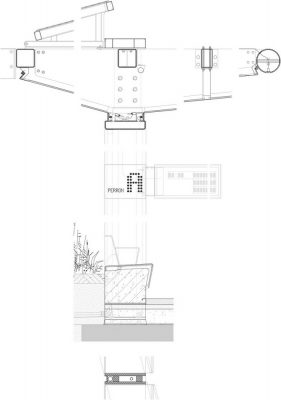
drawings © architectenbureau cepezed
The awning circulation runs from 14 to 30 meters width in total and has two offsets in its contour. These are primarily functional and align with the urban context, but visually, they also resonate elegantly with the monumental roof structure of the train station. This also has an articulated structure and moreover seems to float, just like the bus station awning. The setoffs divide the overall structure into three segments. In the centre of every segment, there is green plantation surrounded by a sitting edge for the travellers. On the wide end of the circuit, the centre additionally contains a pavilion. This houses a staff canteen for the bus drivers, a public transport service point and a commercial space that has to find its function yet. An elevated terrace adjoins this commercial space.
Awning with pv and etfe
The spacious awning all around fully covers the bus platforms and additionally part of the buses. Thus, travellers can always board and deboard sheltered and protected from the rain. The structure consists of a steel framework covered with ETFE-foil. The lighting is fitted above this foil. During the day, the awning filters the sunlight, while during the dark hours, it becomes one large and spacious lighting element that strongly adds to the travellers’ feeling of safety. 250 m2 of solar panels lie atop of the awning. In strong daylight, these cast a shadow pattern on the ETFE that makes the travellers aware of their presence. The panels supply sufficient energy for all functionalities of the bus station, including the lighting of the awning, the digital information signs, the staff canteen and the public transport service point. The commercial space has its own energy circuit and energy meter.
Integral materialization and detailing
Based on considerations regarding aesthetics as well as comfort, functionality and the use of materials, a lot of attention was paid to a setup, materialization and detailing that is as elementary as possible. Cepezed conceived a clear and pure system for the bus station and engineered it meticulously. For example, the thin columns composed of steel plates and strips also contain water drainage and electric cabling.
The S.O.S.-button and intercom are also integrated into one of the columns. The folded sheet steel that functions as the central load-bearing stability beam also functions as a gutter. The lighting of the terrace adjoining the pavilion is integrated into the beams spanning the awning structure at that point. The sitting edges of black pigmented concrete contain a number of seats executed in strip steel with integrated heating.
The drainage holes in the load-bearing gutter are also used for fixation of the stretched ETFE-foil, while the digital information displays are invisibly fastened. The pavilion has a function in the overall stability of the awning. Also, movement sensors have been integrated into the steel edge of the awning every 14 meters. These respond to the presence of busses and people so that the lighting is sufficient in every situation while the use of energy is kept to a minimum.
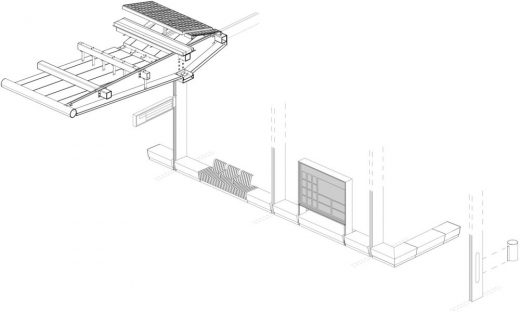
drawing © architectenbureau cepezed
Inclusive, low maintenance and future proof
The bus station was also designed for inclusiveness. For example, the elevated terrace can be reached by wheel chairs through a ramp and the handrails between the terrace and the platforms have been provided with braille signing.
The ETFE foil of the awning is self-cleaning and hardly needs any maintenance. For service on the solar panels and electrical equipment, the awning circulation is easily accessible via the pavilion and a walkable cable gutter. The overall unornamented design with a minimum of edges and corners reduces the costs for cleaning. Additionally, for the future, the bus station is already prepared for the placement of extra electrical equipment that can quickly charge electrical busses.
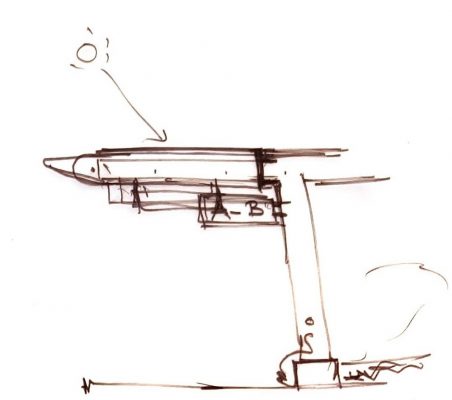
drawing © architectenbureau cepezed
Tilburg Bus Station, Holland – Building Information
Architect: cepezed
Project: bus station Tilburg
Address project: Spoorlaan, Tilburg
Client: City council Tilburg
Architect: architectenbureau cepezed, Delft
Structural engineering: IMd Raadgevende Ingenieurs, Rotterdam
Consultant mechanical & electrical engineering: Nelissen Ingenieursbureau b.v., Eindhoven
Consultant building physics, fire safety and Sustainability: Nelissen Ingenieursbureau b.v., Eindhoven
Landscape architect/urban planner: Atelier Quadrat, Rotterdam
Lighting: Atelier LEK, Rotterdam
Main contractor: BAM Infra bv, Gouda
Contractor steel construction: Buiting Staalbouw, Almelo
Contractor installations: Hoppenbouwers Techniek, Udenhout
Etfe roof: Buitink – Technology, Duiven
Design phase: October 2016 – September 2017
Construction phase: March 2018 – March 2019
Length and width | gfa building: 160 m en 30 m (at widest point) | 108m² bvo
Sustainability: 250 m² of solar panels on the roof; yield = NOM (zero use on the electric bill)
Photography: cepezed | Lucas van der Wee
About cepezed
cepezed is a frequently decorated architecture office with a wide range of projects both in and outside its home country The Netherlands. Assignments address high-profile and sustainable projects such as the revitalization of State Office De Knoop, the circular catering pavilion The Green House, the dismountable Temporary Courthouse in Amsterdam and the new pier at Schiphol Airport, but also e.g. state-of-the-art laboratories, infrastructure and ingenious educational buildings.
At cepezed, projects are designed as monuments of function for people, not monuments of thanks to an architect. There is a lot of attention for a high sojourn quality and a long-term, flexible ease of use. Aesthetics and functionality are logically linked in the designs and the office is high-skilled at managing the complexity behind simplicity. cepezed uses an integral design method in which building components often fulfil various functions at the same time. This way, the agency forges various aspects such as spatial design, construction and installation techniques into an indivisible whole.
cepezed has a lot of in-house knowledge: there are internal specialists for every design part and the office has separate departments and sister companies for interior design, property development and construction management. With a constant focus on buildable and high-quality architecture, the various branches collaborate closely and transparently.
Images: Lucas van der Wee and architectenbureau cepezed
Tilburg Bus Station in Holland images / information received 010519 from v2com newswire
Location: Tilburg, Netherlands
Architecture in The Netherlands
Contemporary Dutch Architecture
Netherlands Architecture Designs – chronological list
A recent Dutch building by by cepezed on e-architect:
Moreelsebrug Utrecht, Utrecht, The Netherlands
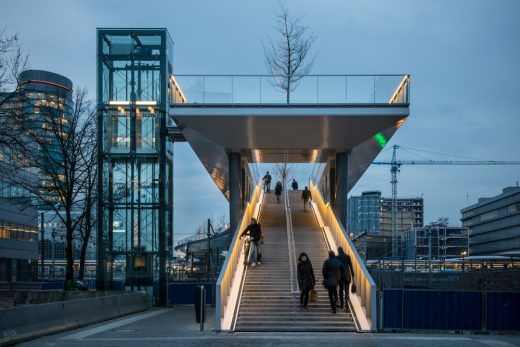
photos © Jannes Linders cepezed
Moreelsebrug Utrecht by cepezed
New Bus Station Buildings – chronological list
Marga Klompé Building, Tilburg: First mass-timber academic building in Europe
Architect: Powerhouse Company
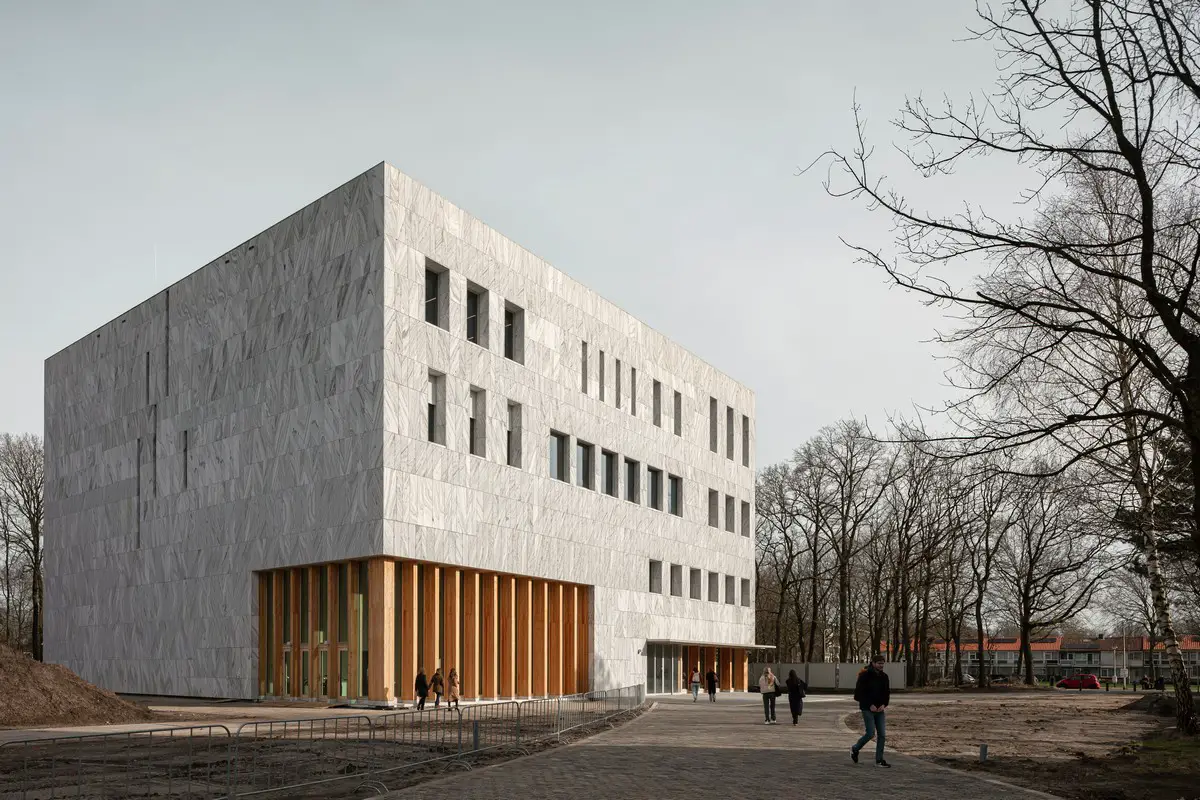
image : Powerhouse Company
Circular Cube, Tilburg University Lecture Hall
Amsterdam Architecture Walking Tours by e-architect
Dutch Architect – design firm listings
Cartesiusdriehoek Blue District, Utrecht, Netherlands
Architects: Mecanoo architecten
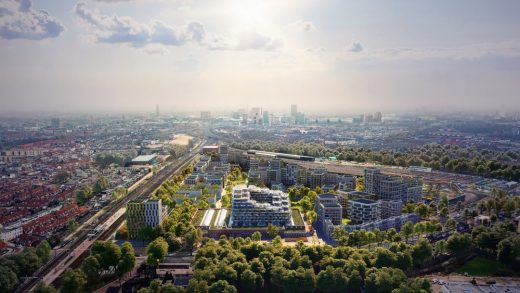
image courtesy of architecture office
Cartesiusdriehoek Blue District Utrecht
, Den Haag, The Netherlands
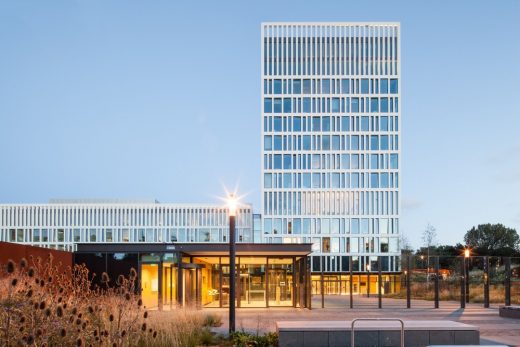
photo from architects office
Eurojust Den Haag
Comments / photos for the First Self-Sufficient Bus Station in Holland page welcome

